A blog formerly known as Bookishness / By Charles Matthews
"Dazzled by so many and such marvelous inventions, the people of Macondo ... became indignant over the living images that the prosperous merchant Bruno Crespi projected in the theater with the lion-head ticket windows, for a character who had died and was buried in one film and for whose misfortune tears had been shed would reappear alive and transformed into an Arab in the next one. The audience, who had paid two cents apiece to share the difficulties of the actors, would not tolerate that outlandish fraud and they broke up the seats. The mayor, at the urging of Bruno Crespi, explained in a proclamation that the cinema was a machine of illusions that did not merit the emotional outbursts of the audience. With that discouraging explanation many ... decided not to return to the movies, considering that they already had too many troubles of their own to weep over the acted-out misfortunes of imaginary beings."--Gabriel García Márquez, One Hundred Years of Solitude
Tuesday, October 25, 2016
In the Realm of the Senses (Nagisa Oshima, 1976)
Even 40 years later, In the Realm of the Senses still has the power to shock, and not just because of the full nudity and unsimulated copulation -- we've all seen pornography in some form. It's that we've never seen them used in service of story, characterization, and theme as well as they are in this film. It's based on an actual incident that took place in Japan in 1936: Sada Abe killed her lover, Kichizo Ishida, during an experiment in erotic asphyxiation, then cut off his genitals and carried them with her for three days until she was arrested. Fascinated by this story, and by producer Anatole Dauman's suggestion that they should make a pornographic film, Oshima wrote the screenplay and set about putting together a cast and crew. The lead actors, Tatsuya Fuji as Kichizo and Eiko Matsuda as Sada, are extraordinary, transcending the mere shock value of their physical encounters with their commitment to illuminating the motives and the inner life of the couple. They give as complete a portrait of sexual obsession as we're ever likely to encounter in a movie. Oshima doesn't skimp on portraying the excesses of their passion: Sada persuades Kichizo to have sex with the 68-year-old geisha who comes to serenade them -- he is somewhat disgusted, but she is aroused when he does. The maids who tend to their room complain that it smells -- "We like it that way," Sada replies -- and the older man with whom Sada has been having sex to get money to support the lovers ends their relationship by saying she smells somewhat like a dead rat. But Oshima also portrays them as symbolic rebels against the militarism of 1930s Japan -- making love not war, if you will -- in a scene in which Kichizo, returning to Sada, passes marching troops being cheered by flag-waving schoolchildren. The real Sada was tried for his murder and mutilation, but served only five years in prison and became something of a folk legend in Japan, living on until the 1970s. A French and Japanese co-production, In the Realm of the Senses was filmed in Japan, but the footage had to be developed in France to avoid prosecution, and it has never been released in Japan without cuts or strategic blurring of its sex scenes. The movie is often quite beautiful, with cinematography by Hideo Ito and sets by Shigemasa Toda, but it's certainly not a film for all viewers.
Links:
Anatole Dauman,
Eiko Matsuda,
Hideo Ito,
In the Realm of the Senses,
Nagisa Oshima,
Shigemasa Toda,
Tatsuya Fuji
Subscribe to:
Posts (Atom)
